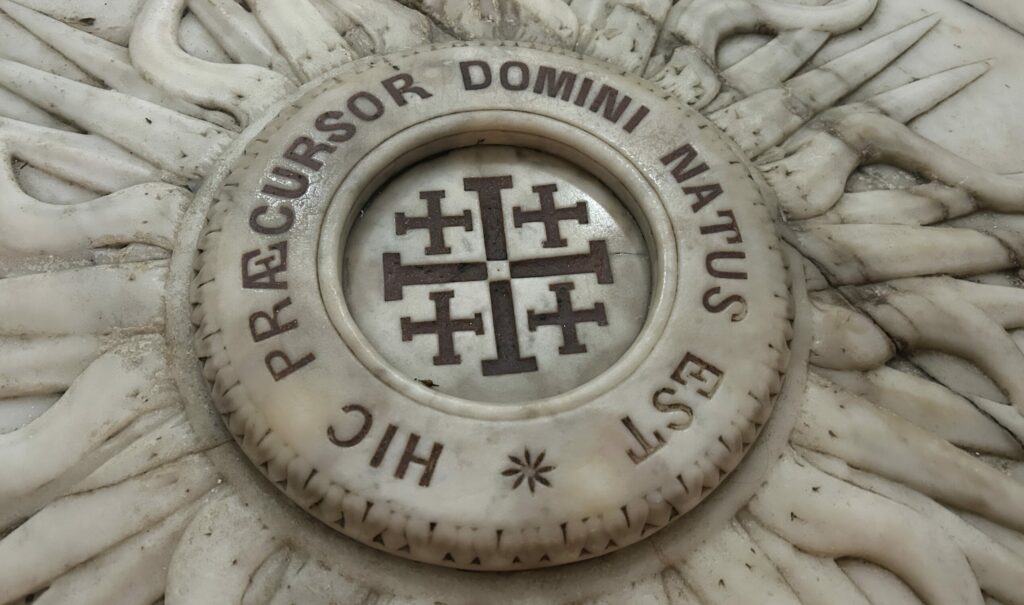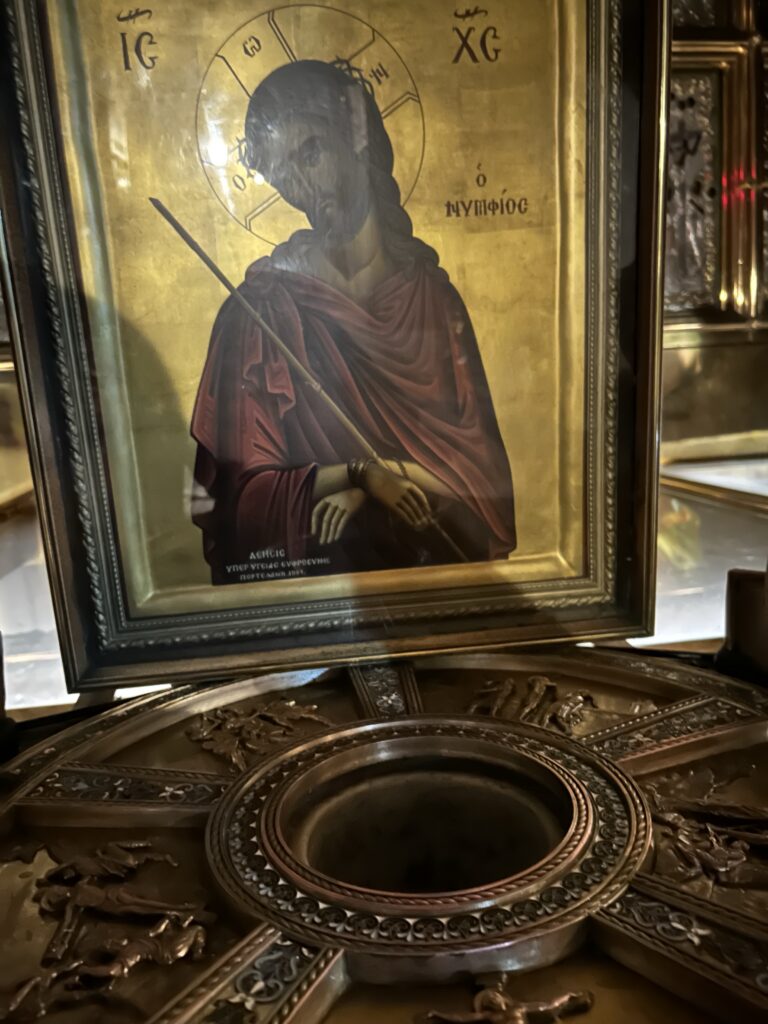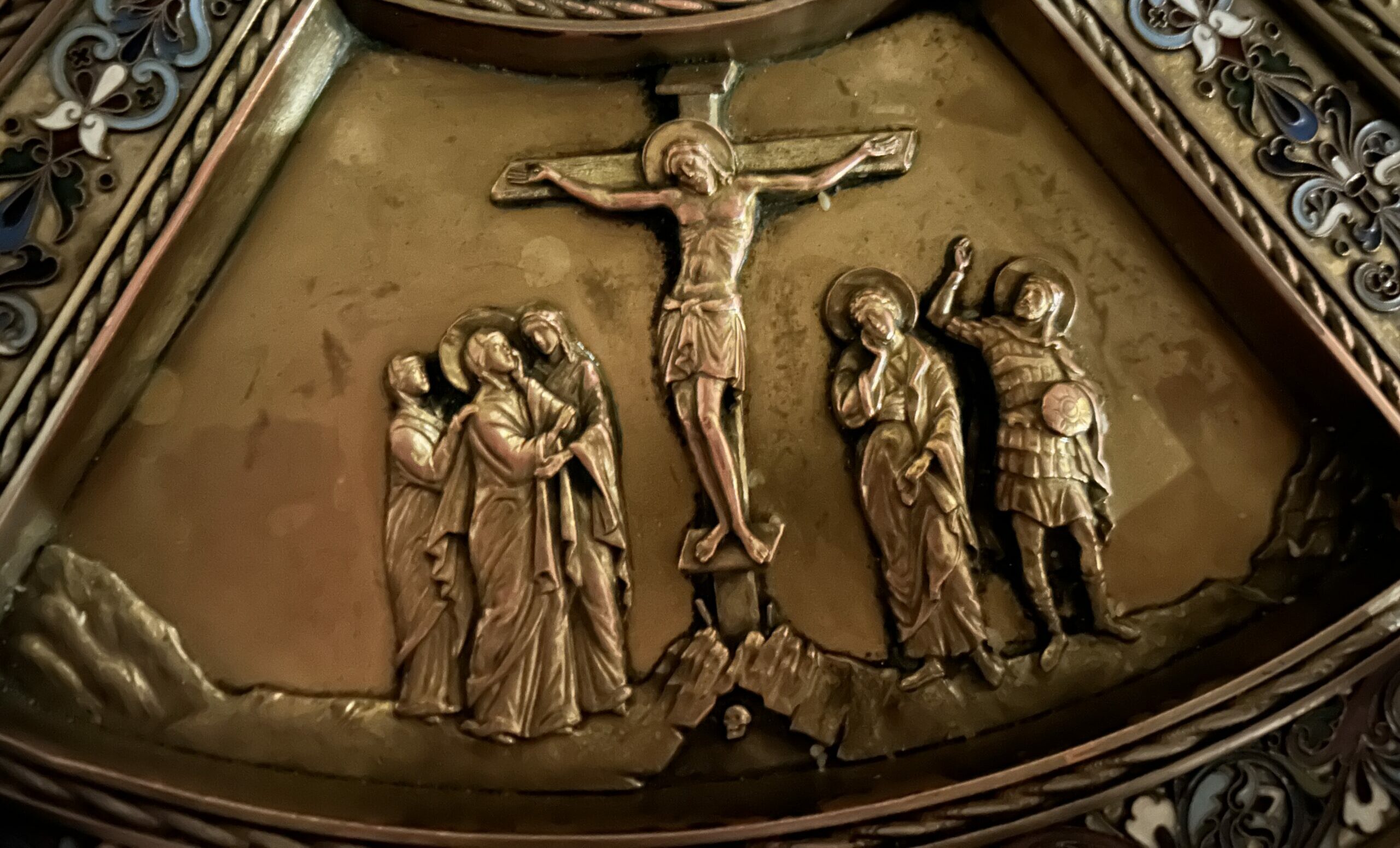In Christ’s Passion, we see what we ought to suffer for the truth, and in His resurrection, what we ought to hope for in eternity.—St. Thomas Aquinas

At Golgotha in the Church of the Holy Sepulchre in Jerusalem, one can go to the exact site where Jesus Christ was crucified. Under a Greek altar, one can put one’s fist into a hole going to the rocks split asunder and also where tradition tells us the Cross was placed during the crucifixion of the Son of God. Of all the icons that could have been used directly above the hole into the ground of Calvary’s cross, they chose “Christ the Bridegroom.” See the word in Greek, “O Nymphios,” meaning The Bridegroom.
Before we get to the true interpretation of the priesthood, let’s look at some limping ones.
Nowadays, a Catholic seminarian attending a mainstream American seminary will often be told he is going to “marry the diocese” or “marry his parish.” This is not heretical since the priest is indeed called to sacrifice himself as Christ did: Husbands, love your wives, as Christ loved the Church and gave Himself up for her, that He might sanctify her, having cleansed her by the washing of water with the word, so that He might present the Church to Himself in splendor, without spot or wrinkle or any such thing, that she might be holy and without blemish.—Eph 5:25-27.
The priest marrying his parish is not to live an easy bachelor life, but rather the priest should “give himself up” for the parish (or religious community’s mission) in order to cleanse her of sin. Of course, this is done by his own interior life, teaching and the sacraments. So, it’s not the worst theology.
On the other hand, the notion of a priest marrying his parish presents some problems. Let’s look at some of these problems in my three ever-present categories: Trads, Neo-Cons and liberals.
Traditional Catholic priests go wrong in this theology by sometimes asserting a “husband first” theology. While the priest is called to be the leader of a parish, that doesn’t mean he is to be the king-baby. There is a traditional Catholic parish in Colorado (not in my Archdiocese) where the priests are so rough on parishioners in the confessional that not even children are spared. Families have told me of a certain priest there who quietly peppers children with so many prying questions about their sins in the confessional that they leave the sacrament feeling terrorized. We’re talking about children under 10 years old, not the adults that Padre Pio had to scare for the sake of their souls.
In fact, from what was described to me outside the confessional about inside the confessional, it sounds like that insecure trad priest is more afraid of losing his own soul through fear of missing something in his line of questioning than losing his parishioners’ souls by making them afraid of confession for the rest of their lives. (Does he not know he will also answer to God for making little children cry?) That’s why I call this a “husband first” theology. It is no wonder that certain TLM parish in Colorado is known for having no charity in it and why families have left. As the old phrase goes, “The fish stinks from the head down.”
Neo-con priests also have a weird approach to the “priest as husband to the parish” idea. Some priests have been formed under the Institute for Priestly Formation (IPF) a group of pop-psychology hacks who moonlight in theology. It’s a Freudian system where seminarians are told to focus on their “Father wound” and “bring it to God the Father.” Again, it’s not the worst theology, except here’s the kicker: Those wounds never get healed in that IPF system. Imagine a group of never-healed priests bringing this wound-licking into “marrying a parish.” What a disaster. I heard of one other similar group integrating the”Theology of the Body” who had seminarians look at pictures of naked people to get used to “being comfortable” with their bodies.
Do you see how this idea of the priest “marrying” his parish can go bad? We have all heard the stories of the young straight priest who feels so disenfranchised that he joined a bad club of priests that he ends up talking to his lonely, young female secretary all day at work. Perhaps remembering the perverted “training” mentioned in the previous paragraph, he leaves the priesthood and marries her.
“Leftist Catholics” (yes, always in quotes because you can’t hold to the heresy of religious indifferentism and still be a Catholic) scoff at the idea of a priest marrying his parish. For such a parish, Fr. Richard is just known as “Richard” (or worse.) Fr. Richard is just first among equals with the lay people. He is simply a social worker and the guy who has “to preside over the Eucharist” until they all get the fully “synodal church” that they want. There is no advanced theology of Ephesians 5 and Christ’s sacrifice happening here. Why? Because sacrifice is missing from the leftist vocabulary and because gay priests don’t understand the theology of marriage.
But Jesus Christ can only have one spouse, the Catholic Church: For the husband is the head of the wife even as Christ is the head of the Church, his body, and is Himself its Savior.—Eph 5:23. Of course, the inverse must also be true: The Catholic Church can only have one spouse, and that is Jesus Christ (not a bishop or a priest.)
Of course, the easy rebuttal to the above paragraph is: “But the priest is an alter-Christus, another Christ, meaning Christ marries His Church through the priest!” Yes, there is truth to this fine rebuttal, but there’s a higher theology.

Fr. Gary wrote in Friend of the Bridegroom:
St. Augustine, for example, taught that John, the best friend of Christ, did not have the right to take the Bride of Christ and thus could not be called the Bridegroom. In his dispute with the Donatists, Augustine saw the bishop as symbolized by the friend of the Bridegroom, “he who has the Bride is the Bridegroom; the friend of the Bridegroom, who stands and hears him” and “rejoices greatly at the Bridegroom’s voice” (Jn 3:29):
“All good pastors are in one and are one. They tend the flock and Christ tends the flock. For the friends of the Bridegroom do not say that they rejoice in their own voice, rather, they rejoice on account of the voice of the Bridegroom. It is Christ himself, therefore, who tends the flock when they are tending it. He says, “I tend it,” because his voice is in theirs, and in them is his love.”
The authentic pastor listens to the voice of Christ and is able to speak with Christ’s own voice. He finds joy in being an intermediary between the Bride and the Bridegroom so that the bridal Church may belong only and wholly to Christ. With this in mind Augustine argued that the bishop is not the Bridegroom himself, but the best friend, who is able to facilitate the coming together of the Bride and the Bridegroom. The bishop therefore acts in an intermediary role between Christ and the Church, rather than in the role of Christ the Bridegroom himself. Augustine was careful to avoid saying that the bishop was the Bridegroom of the Church in order to preserve Christ’s unique spousal role in relation to the Church.
I think the theology of the “Best Man” is a safer theology for the Catholic priesthood. It prevents the bishop or priest from labeling his arbitrary decisions “the decisions of God.” (The claims to “obedience” that have nothing to do with the Magisterium these days are getting more and more cult-like the more leftist the hierarchy goes. And I don’t use the word “cult-like” lightly when I see the constant use of “obedience” to cover up heresy and even crimes in the Catholic Church today.)
On the contrary, striving for true traditional Catholicism makes sure the bishop and the priest reflect the Holy Spirit to their people. How does a bishop reflect the Holy Spirit to his people? As Fr. Gary wrote above, The authentic pastor listens to the voice of Christ and is able to speak with Christ’s own voice… The bishop therefore acts in an intermediary role between Christ and the Church, rather than in the role of Christ the Bridegroom himself.”
Therefore, the very minimum (not the maximum) of a good priest or bishop is absolute and total orthodoxy.
The priest should then be compared to St. John the Baptist who said: You yourselves bear me witness, that I said, I am not the Christ, but I have been sent before him.’ The one who has the bride is the Bridegroom. The friend of the Bridegroom, who stands and hears Him, rejoices greatly at the Bridegroom’s voice. Therefore this joy of mine is now complete. He must increase, but I must decrease.—John 3:28-30.
Notice that the priest or prophet should decrease in order for Christ to increase in the world. This means sidelining modern gimmicks to be relevant. Only Christ (the Bridegroom) has married the Catholic Church (the Bride.) His best-men do only His bidding, not their own. And how do they know that? It shouldn’t be from following their emotions, but by following the early Fathers and the early sacraments.
Notice also how St. John the Baptist describes himself as the “Friend of the Bridegroom.” In modern parlance the term “friend of the bridegroom” can be translated as “The Best Man.” Therefore, put together St. Paul and St. Augustine and St. John the Baptist, and the conclusion on the priesthood is clear: Only Christ marries the Church, but the Catholic bishop or the Catholic priest is called to be the Best Man at the wedding.
Slight switch of gears, but we’ll come back to the above topic. In Mark 3, the Pharisees and disciples of John the Baptists (many of whom later became followers of Christ) are challenging Jesus’ followers for not fasting as much as them:
Now John’s disciples and the Pharisees were fasting. And people came and said to Him, “Why do John’s disciples and the disciples of the Pharisees fast, but Your disciples do not fast?” And Jesus said to them, “Can the wedding guests fast while the Bridegroom is with them? As long as they have the Bridegroom with them, they cannot fast. The days will come when the Bridegroom is taken away from them, and then they will fast in that day.—Mk 2:18-20.
The Greek of Mk 3:19 above calls the disciples οἱ υἱοὶ τοῦ νυμφῶνος (Hoi Huioi Tou Numphonos.) Huioi means sons. Numphonos means bridegroom. Thus, the disciples of Christ (many of whom later became bishops and priests) are called “the Sons of the Bridegroom.”

Fast forward to the foot of the Cross. Remember the only icon at the foot of Calvary in Jerusalem calls Christ ο νυμφiος, that is to say, the Bridegroom. Christ is stripped, beaten and given a rod as a fake-scepter to mock him. So also, any real Catholic priest holding to the traditional orthodox faith will today be recognized only by other Catholics mocking him. (I know several faithful priests treated like this.) We remember the words of St. Thomas Aquinas again: “In Christ’s Passion, we see what we ought to suffer for the truth, and in His resurrection, what we ought to hope for in eternity.”
Where do we see the single disciple who did not flee? St. John the Beloved is with Mary, adoring His dying Lord and Savior. Before dying, Christ gives Mary to be the mother of John. Mary is the exemplar of the Catholic Church. John is the exemplar of every disciple to come. Therefore, the priest is called to be a son of Mary and a son of the Church. No need for any gimmicky power-trips. Just hand over the dogma and liturgy you were given. This is the importance of tradition in any solid theology on the priesthood.
Put this all together, and we have quite a bit of evidence the priest is simply called to be the Best Man of Christ’s marriage to His Church and/or a direct spiritual Son of Christ as St. John the Apostle was at the foot of the Cross. Like Christ and St. John the Baptist, the good priest is going to be crucified for the truth. In fact, we know from Our Lady of Fatima that (like St. John the Baptist’s plight) the final battle against the antichrist “will be over marriage and family.” (Notice she didn’t say liturgy, meaning the anti-christ and his advisors will be recognized by his rejection of sexual teachings of the Catholic Church. Come to think about it, shocking truth here, but I know of two big-shots in Rome over the last fourteen years who fit that bill!)
But the main point here is that the priest always takes second-place to Christ in His marrying of the Church. Christ died for her to give her the Faith that no man can change.
